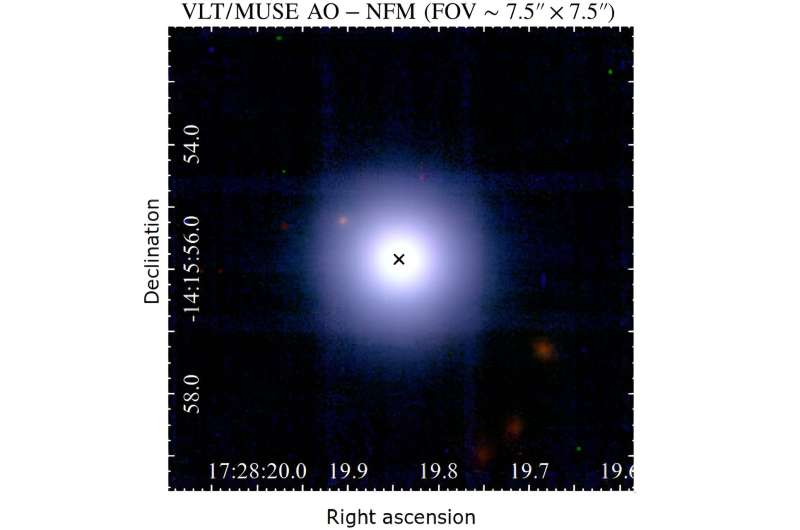MUSE image centered on the quasar PDS 456. Credit: Travascio et al., 2024.
Using the Multi Unit Spectroscopic Explorer (MUSE) at the Very Large Telescope (VLT) in Chile, an international team of astronomers has inspected a luminous quasar known as PDS 456. Results of the observational campaign, published March 26 on the pre-print server arXiv, shed more light on the ionized emission from this quasar.
Quasars, or quasi-stellar objects (QSOs) are active galactic nuclei (AGN) of very high luminosity, emitting electromagnetic radiation observable in radio, infrared, visible, ultraviolet and X-ray wavelengths. They are among the brightest and most distant objects in the known universe, and serve as fundamental tools for numerous studies in astrophysics as well as cosmology. For instance, quasars have been used to investigate the large-scale structure of the universe and the era of reionization. They also improved our understanding of the dynamics of supermassive black holes and the intergalactic medium.
At a redshift of 0.185, PDS 456 is a nearby luminous radio-quiet quasar. With a bolometric luminosity at a level of one quattuordecillion erg/s, it is the most luminous radio-quiet quasar at a redshift below 0.3. Previous observations of PDS 456 have found that it exhibits relativistic and powerful ultra fast X-ray winds, and a massive and clumpy carbon monoxide molecular outflow extending up to 16,000 light years eastward from the nucleus.
A group of astronomers led by Andrea Travascio of the University of Milano-Bicocca in Italy, decided to take advantage of MUSE's large field of view to investigate PDS 456. MUSE allowed Travascio's team to map with unprecedented detail the ionized emission from this quasar with a multi-scale, multi-phase outflow.
First of all, the observations show that PDS 456 resides in a complex environment characterized by the diffuse emission of ionized gas extending up to a maximum projected distance of 150,000 light years. This environment includes a reservoir of gas with a mass of about 10–100 million solar masses, eight companion galaxies, and a multi-phase outflow.
MUSE observations identified an outflow of doubly ionized oxygen with a velocity of 600 km/s. The outflow has a projected size of about 65,000 light years and a velocity gradient along the east-west direction. The outflow mass rate was calculated to be at a level of 2.3 solar masses per year, which is significantly lower than in quasars with similar bolometric luminosity.
The study found that the hydrogen-alpha outflow shows a similar scale, morphology, and kinematics to the carbon monoxide molecular outflow. This finding suggests that these two components belong to the same multi-phase outflow and could be driven from the same past AGN feedback episode.
All in all, the authors of the paper underlined that the new results deliver important insights into the complex interplay between the different phases of AGN-driven outflows and the richness of the circumgalactic environment of PDS 456.
"This may help in planning and performing future multi-band investigations of the properties of the luminous quasars shining at cosmic noon," the researchers concluded.
More information: A. Travascio et al, MUSE view of PDS 456: kpc-scale wind, extended ionized gas and close environment, arXiv (2024). DOI: 10.48550/arxiv.2403.18043
Journal information: arXiv
© 2024 Science X Network
























